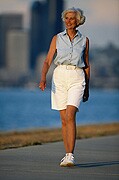
FRIDAY, April 27 (HealthDay News) — In recent years, more Americans have embraced the habit of taking leisurely walks, a new government analysis reveals.
The finding stems from a comparison of two national physical activity surveys, which indicated that while 41.5 percent of Americans engaged in leisure-time walking in 2005 that figure jumped to 49.6 percent just five years later.
The seemingly good news was further reinforced by the finding that those who take such walks are more likely than non-walkers to be meeting aerobic activity guidelines set in 2008 by the U.S. Department of Health and Human Services (HHS).
However, not all the news was rosy.
The research team, from the U.S. Centers for Disease Control and Prevention, found that despite the fact that more people are going out for walks, the amount of overall time these walkers actually walk has shrunk by more than 10 percent.
“It was a big surprise, both in terms of the amount of the increase in leisure-time walking, but also in terms of the overall decrease in the time spent walking,” acknowledged lead researcher Prabasaj Paul, an epidemic intelligence officer with the U.S. National Center for Chronic Disease Prevention and Health Promotion, which is part of the CDC.
“But, overall, we believe that the results are encouraging,” he said. “Because any physical activity is better than no activity, and that is true even for physical activity at low levels.”
Paul and his colleagues presented their findings recently at a CDC Epidemic Intelligence Services Conference held in Atlanta.
The CDC team noted that walking is currently the most common form of leisure-time activity among American adults.
Specifically in terms of aerobic activity, HHS recommendations suggest that adults engage in either 150 minutes per week of “moderate” physical activity (such as brisk walking at least three miles an hour, but not race-walking); or 75 minutes per week of “vigorous activity” (such as running, swimming laps, aerobic dancing, bicycling at least 10 miles per hour or hiking uphill with a heavy backpack); or some combination of both. At all times, activities should last a minimum of 10 minutes in length.
In the study, the researchers focused on leisure-time walking, a “moderate” activity that was defined as strolling for fun, relaxation or to walk the dog. Participants were asked to indicate whether or not they had engaged in such walking for at least 10 minutes in the week leading up to the survey and, if so, how long such walks lasted.
In addition to the principal findings, the team noted that a much higher percentage of leisure-time walkers were meeting HHS aerobic goals compared with non-walkers: nearly 61 percent versus 29 percent, respectively.
Paul said that the CDC analysis was not able to pinpoint the specific reasons for the apparent changes in walking trends. But he suggested that, regardless, leisure-time walking appears to be key to helping the public get a foothold on the road to optimal aerobic health.
Jessica Matthews, a San Diego-based exercise physiologist with the American Council on Exercise, agreed.
“First of all, clearly walking is very accessible for most individuals,” she said, noting that it’s inexpensive and convenient, no matter where you live.
“If you have a decent pair of sneakers you can get up and get moving,” Matthews said. “And it’s particularly a good way for individuals who want to start getting active to take their first step, which is why I would think we’re seeing this percentage increase in the amount of people for whom walking has now become a regular part of their routine.”
More information
For more on the 2008 Health and Human Services physical activity guidelines, visit the U.S. Department of Health and Human Services.

